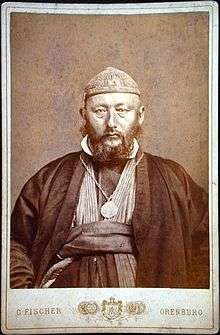Starshina
Starshina (Russian: Старшина) might be in Slavonic armed forces, the designation of a military rank, comparable to OR-8[1] in NATO, or a military appointment, comparable to company sergeant major in the Army. The equivalent in the modern days Russian Navy is Glavnyj starshina of the ship, OR-8 as well.
in the Russian Army | |
|---|---|
  | |
| Rank insignia | Armed Forces of the Russian Federation |
| Introduction | 1942 to the Red Army |
| Rank group | Non-commissioned officers |
| Army / Air Force | Starshina |
| Navy | Glavnyj starshina of the ship |
| NATO equivalent | OR-8 |
Russian Federation
Starshina (Russian: старшина́, Ukrainian: старши́на, from старший, starshyi, "senior"), initially was a Cossacks officership, but in Soviet time it was, and in the Russian Federation it is used as the Company sergeant major at the one hand and the top non-commissioned officer at the other hand.
In Tsardom of Russia and later Imperial Russia of 17-20th centuries a volostnoy starshina was a chief of a volost (a rural administrative unit). He was in charge of the distribution of taxes, resolving conflicts within obshchina, distribution of the usage of community lands, assigning people for military service, etc.
-

Uzbek, stashina (аксакал) village Chodshagent (ru: Ходжагент), 1868, drawing by V.V. Vereshchagin.
The rank of voiskovoi starshina (Войсковой старшина - "Starshina of the Army (Host)") was introduced into Russian military ranks in 1826, as equivalent of a Lieutenant Colonel in the Cossack cavalry.
In the Soviet Army, a starshina was the highest non-commissioned officer among conscripts; this was changed by reintroduction of the higher-ranking praporshchik in 1972. In the Soviet Navy, it was introduced in 1942 as a petty officer rank; every enlisted seaman ranking above Matrose, 1st class is a starshina of various ranks.
In the army of the Russian Federation there are four ranks in the NCO´s career group, which means:
- Starshina (OR-8)
- Starshy sershant (OR-7)
- Sershant (OR-6)
- Mladshy sershant (OR-4)
| junior rank | Starshina OR-8 |
senior rank | |||
|---|---|---|---|---|---|
| USSR |  | from 1935 | Mladshy kom'vsvoda | Mladshy leytenant OF-1-c | |
| c 1940 | Starshy sershant OR-7 | ||||
| с 1971 | Praporshchik OR-9b | ||||
| RF | .svg.png) | from 1991 | |||
 | from 1993 | ||||
Red Army (RA), Soviet Army (SA), and Russian Federation Armed Forces (RFAF) starshina rank insignia
-

sleeve insignia
RA
(1919−1924) -
gorget insignia
to gymnastjorka
RA (1924−1940)
from 1940 — Starshiy sershant -

...
RA
(1935−1940)
shoulder boards
-

Engineer troops
parade uniform
RA (1943−1955) -

infantry
SA
(1955−1963) -

Air Forces,
Air defence aviаtion,
Navy aviаtion,
Airborne troops
SA (1955−1963) -

infantry
SA and RFAF
(1963−1994
and from 2010) -

Air Force
SA and RFAF
(1963−1994
and from 2010) -

Air Forces,
Airborne troops,
Space Forces
kursant uniform
RFAF (1994−2010) -

Ground Forces,
SMT
RFAF (1994−2010) -

Ground Forces, SMT, SF, Airborne troops,
Air Forces, Air Defence, Marines, etc.
field uniform
RFAF (1994−2010) -

Police
(before 2011 — Militsiya),
Ministry of Internal Affairs (Russia).
Ukraine
Among Cossacks in Ukraine, starshyna was a collective noun for categories of officership or a military elite: junior starshyna (Молодша старшина), general starshyna (Генеральна старшина), military starshyna (Військова старшина), substarshyna (Підстаршина). Polkovnyk or 'colonel' was the next higher rank. Later sometime after the Khmelnytsky's Uprising it also was associated with the Ukrainian nobility which derived out of the officership and the Hetman.
See also
- Ranks and rank insignia of the Red Army 1918–1935, ... 1935–1940 and ... 1940–1943
- Ranks and rank insignia of the Soviet Army 1943–1955 and Ranks and rank insignia of the Soviet Army 1955–1991,
- Ranks and rank insignia of the Russian Federation´s armed forces 1994–2010
Rank designation in other countries
In the countries below, spelling is similar and the classification to a separate rank group is equivalent.
 ⇒ Belarusian: Старшыня; starshyna
⇒ Belarusian: Старшыня; starshyna ⇒ Bulgarian: Старшина; starshina
⇒ Bulgarian: Старшина; starshina ⇒ Ukrainian: Старшина; starshina
⇒ Ukrainian: Старшина; starshina
References
- This article incorporates information from the equivalent article on the Russian Wikipedia.
- ↑ The NATO abbreviation "OR" stands for "other ranks"
